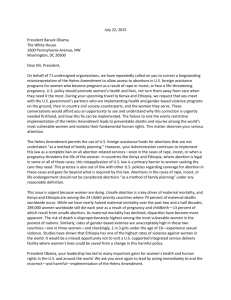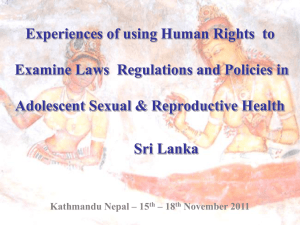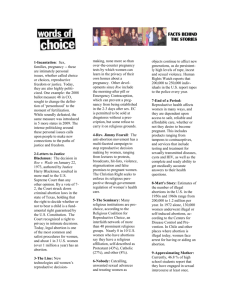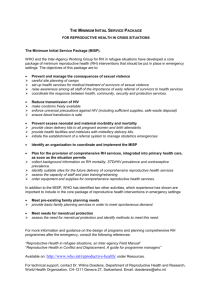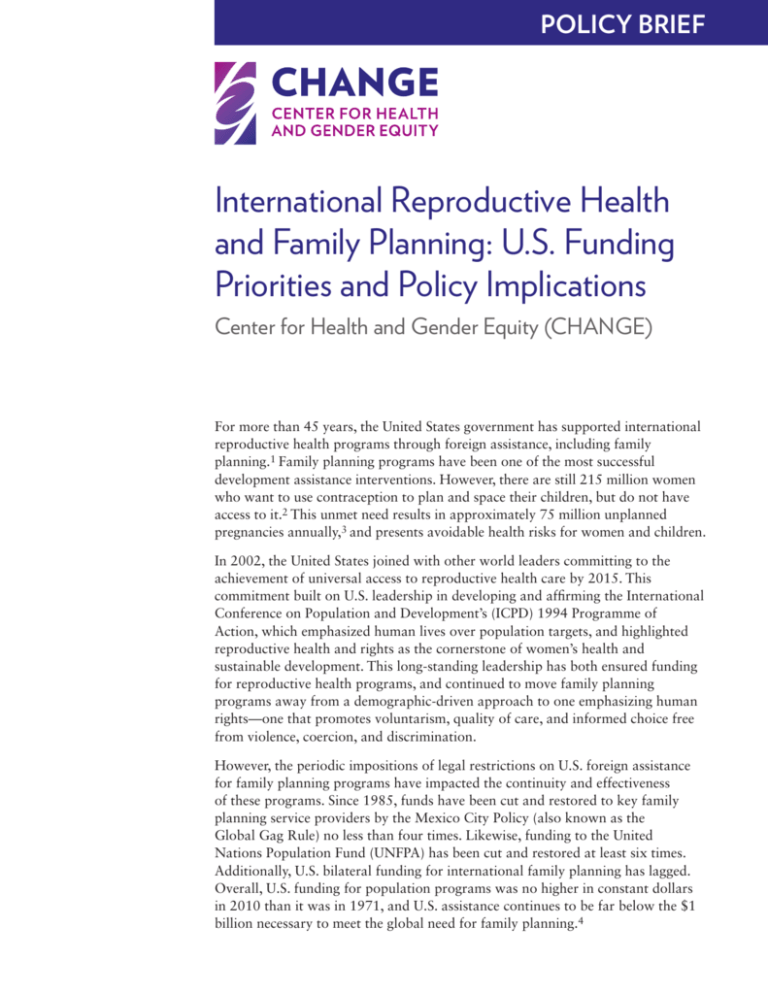
POLICY BRIEF
International Reproductive Health
and Family Planning: U.S. Funding
Priorities and Policy Implications
Center for Health and Gender Equity (CHANGE)
For more than 45 years, the United States government has supported international
reproductive health programs through foreign assistance, including family
planning.1 Family planning programs have been one of the most successful
development assistance interventions. However, there are still 215 million women
who want to use contraception to plan and space their children, but do not have
access to it.2 This unmet need results in approximately 75 million unplanned
pregnancies annually,3 and presents avoidable health risks for women and children.
In 2002, the United States joined with other world leaders committing to the
achievement of universal access to reproductive health care by 2015. This
commitment built on U.S. leadership in developing and affirming the International
Conference on Population and Development’s (ICPD) 1994 Programme of
Action, which emphasized human lives over population targets, and highlighted
reproductive health and rights as the cornerstone of women’s health and
sustainable development. This long-standing leadership has both ensured funding
for reproductive health programs, and continued to move family planning
programs away from a demographic-driven approach to one emphasizing human
rights—one that promotes voluntarism, quality of care, and informed choice free
from violence, coercion, and discrimination.
However, the periodic impositions of legal restrictions on U.S. foreign assistance
for family planning programs have impacted the continuity and effectiveness
of these programs. Since 1985, funds have been cut and restored to key family
planning service providers by the Mexico City Policy (also known as the
Global Gag Rule) no less than four times. Likewise, funding to the United
Nations Population Fund (UNFPA) has been cut and restored at least six times.
Additionally, U.S. bilateral funding for international family planning has lagged.
Overall, U.S. funding for population programs was no higher in constant dollars
in 2010 than it was in 1971, and U.S. assistance continues to be far below the $1
billion necessary to meet the global need for family planning.4
Although President Barack Obama reversed the Mexico City Policy as one of
his first official acts and removed impediments to U.S. funding for UNFPA in
February 2009, challenges to providing sufficient funding for effective family
planning programs remain. In May 2009, President Obama introduced the U.S.
Global Health Initiative (GHI), a new approach to global health that focuses on
addressing critical health concerns, including family planning, maternal and child
health, HIV/AIDS, tuberculosis, malaria, and neglected tropical diseases, in an
integrated way that increases the efficiency of existing global health programs. The
GHI gives the U.S. the opportunity and the mechanism to reconsider the policies
and low funding levels that have been proven to hamper U.S. family planning
programs.
GLOBAL NEED FOR INTERNATIONAL FAMILY PLANNING ASSISTANCE
Voluntary family planning programs are critical to assisting women and men
to plan families, space childbirths, and prevent death and illness related to
pregnancy. Yet, in the world’s developing countries, some 215 million women
have an expressed need for safe and effective family planning methods, but cannot
access them.5 The lack of access to voluntary family planning is a major cause
of mortality for the more than 356,000 women a year who die from pregnancy
and childbirth complications.6 All but one percent of these deaths take place
in developing countries.7 Without family planning, women cannot manage
their pregnancies. One result is that 40,000 women die each year from unsafe
abortion.8
Currently, developing countries themselves commit the majority of resources
for these important programs. However, in order to improve health outcomes
for women and children in developing countries, resources available for family
planning must align with the need, which would require a substantial increase
in U.S. foreign assistance for family planning. Moreover, as a leading bilateral
donor for international family planning, the U.S. should ensure that its global
health dollars are being used most effectively by eliminating harmful restrictions
within foreign assistance legislation, and promoting comprehensive, cost-effective
approaches to sexual and reproductive health.
BARRIERS TO EFFECTIVE INTERNATIONAL FAMILY PLANNING ASSISTANCE IN
U.S. POLICY
FUNDING LEVELS
At the ICPD, donor nations agreed to provide one-third of total funding needed in
order to meet the unmet need for contraceptives. While $3.2 billion a year is the
actual amount the U.S. would have to contribute to meet its ICPD commitment to
achieve universal access to comprehensive reproductive health care programs and
services by 2015, this figure is perhaps unreachable in the near-term. However, a
U.S. government contribution of $1 billion dollars in Fiscal Year 2013 would help
satisfy the global unmet family planning need.9 This figure includes $65 million
for UNFPA.
2 Center for Health and Gender Equity (CHANGE)
Figure 1 below illustrates that, although funding has recovered slightly from its
low points in 1999-2001, U.S. bilateral funding for international family planning
assistance continues to fall far below the $1 billion necessary to meet the unmet
need. More concerning is the fact that U.S. contributions to international family
planning have declined substantially in real dollars since their high-water mark in
1995.
Source: Population Action International10
MEXICO CITY POLICY (GLOBAL GAG RULE)
The Mexico City Policy, not currently in force, stipulates that nongovernmental
organizations receiving U.S. family planning assistance cannot use their own, nonU.S. funds to inform the public or educate their government on the need to make
safe abortion legal and available, or provide legal abortion services, advice on
where to get an abortion, or information on abortion. When in effect, this policy
does allow for exemptions in the cases of rape, incest, and the life of the mother,
but not for a woman’s physical or mental health.11 Organizations that refuse to be
“gagged” in this manner are ineligible to receive U.S. funding.
The Mexico City Policy is controlled solely by the executive branch, meaning the
president has the power to repeal or reinstate the policy without Congressional
approval. It was first put in place by President Ronald Reagan in 1985.
“For too long, international family planning assistance has been a political
wedge issue, the subject of a back and forth debate that has served only to
divide us…It is time that we end the politicization of this issue.”12
—President Barack Obama
upon rescinding the Mexico City Policy, January 23, 2009
3
International Reproductive Health and Family Planning: U.S. Funding Priorities and Policy Implications
Documentation and analyses of the impact of the Global Gag Rule have shown
how the policy harms the health and lives of poor women by limiting access to
family planning services, curtailing a basic right to speech, and restricting the
right to make informed health decisions. Ironically, it has also been found that
the policy does not reduce abortion13 and may actually increase abortion rates.14
Because of its harmful effects, President Bill Clinton repealed the policy in 1993,
but it was reinstated by President George W. Bush in 2001. In a subsequent
memo in August 2003, President Bush extended the policy to “voluntary
population planning” assistance provided by the U.S. Department of State, but
excluded any foreign assistance allocated under the President’s Emergency Plan
for AIDS Relief (PEPFAR).15
President Obama repealed the policy on January 23, 2009. His statement called
for a new approach to family planning that would end the politicization of
women’s health around the world. “For too long, international family planning
assistance has been a political wedge issue, the subject of a back and forth debate
that has served only to divide us,” he said. “I have no desire to continue this stale
and fruitless debate. It is time that we end the politicization of this issue.”16
In 2009, 2010, and 2011, the Senate Appropriations Committee adopted an
amendment offered by Sen. Frank Lautenberg (D-NJ) that would remove the
Mexico City Policy from the president’s control, and instead require any efforts
to repeal or reinstate it to be approved by Congress. This amendment has been
dropped from legislation every year to date.
KEMP-KASTEN AMENDMENT
The Kemp-Kasten Amendment was enacted for the first time in 1985 as part
of an annual appropriations bill. The provision prohibits foreign aid to any
organization that the current administration determines is involved in the
management of a program that includes coercive abortion or involuntary
sterilization.17 While a literal interpretation of Kemp-Kasten supports women’s
reproductive rights, it has been misused by policy makers to oppose reproductive
rights. By using vague terms such as “involvement,” the amendment’s wording
has been open to such abuse.
For example, the George W. Bush administration determined that UNFPA’s18
presence in China could be construed as involvement in China’s coercive family
planning policies.19 As a result, the United States withheld funding for UNFPA
under President Bush from 2002 to 2008.20
In October 2008, the Bush administration took its interpretation a step further
by applying Kemp-Kasten to Marie Stopes International (MSI), an international
family planning organization based in the United Kingdom—despite the fact that
MSI was not receiving any U.S. funding at the time—because the organization
was working with UNFPA in China.21 As a result, USAID issued a directive to
African governments prohibiting the distribution of U.S.-donated contraceptives
to the organization. President Obama restored UNFPA’s U.S. funding in 2009.
MSI is also no longer considered in violation of Kemp-Kasten and now receives
U.S. funds.
4 Center for Health and Gender Equity (CHANGE)
“We find no evidence that UNFPA has knowingly supported or participated
in the management of a program of coercive abortion or involuntary sterilization in the People’s Republic of China.”—Report by U.S. Department of
State fact finding mission sent by the Bush administration in May 2002. The
Bush administration nevertheless cut funding to UNFPA two months later,
citing Kemp-Kasten.
HELMS AMENDMENT
The Helms Amendment was first enacted in 1973, appended to the Foreign
Assistance Act of 1961. The provision states that, “No foreign assistance funds
may be used to pay for the performance of abortion as a method of family
planning or to motivate or coerce any person to practice abortions.”22
USAID has interpreted this amendment to prohibit U.S. funding of abortions that
would preserve the physical or mental health of a woman, though it does make
allowances in cases of rape, incest, or the life of the woman. Nevertheless, USAID
has consistently over-interpreted the Helms language to include those exceptions,
in addition to the purchase of equipment that could be used to perform abortions
or to provide post-abortion care for victims of unsafe abortion23, and providing
information and counseling on abortion.
Worldwide, about 40,000 women die from unsafe abortion every year and
thousands more suffer from life-threatening injuries caused by unsafe abortion
procedures.24 As countries around the world are reforming their abortion laws
in recognition of this major contributor to maternal mortality and morbidity, the
Helms amendment continues to deny U.S. assistance in developing modern service
provision. Poor women are disproportionately affected by this policy, as they
often lack the resources to obtain a safe abortion.
The ICPD Programme of Action states: “All Governments and relevant
intergovernmental and non-governmental organizations are urged to strengthen
their commitment to women’s health, to deal with the health impact of unsafe
abortion as a major public health concern and to reduce the recourse to abortion
through expanded and improved family-planning services.”25
While the U.S. should expand efforts to reduce the need for abortion through
family planning programming and the provision of integrated services, it cannot
continue to ignore the serious health impact of unsafe abortion. In cases where the
U.S. is providing foreign assistance to countries where abortion is legal, and where
the Geneva Convention applies, the U.S. should compassionately help to ensure
that safe abortions are accessible to women who choose them.
THE TIAHRT AMENDMENT
The Tiahrt Amendment outlines a set of guidelines that USAID and their grantees
must follow when conducting family planning programming. Proposed by Rep.
Todd Tiahrt (R-KS) in 1998, the amendment was enacted as part of the Foreign
Operations Appropriations Act of 1999 and has been included every year since.
Specifically, the Tiahrt Amendment restricts USAID and subsidiary family planning
service providers from setting targets or quotas when offering family planning
5
International Reproductive Health and Family Planning: U.S. Funding Priorities and Policy Implications
methods to clients. Providing incentives to clients to accept family planning is
also prohibited, as is withholding essential goods, such as food or health care, if a
client declines to use family planning services.26
Providers must also supply “comprehensible information about the health benefits
and risks of the [planning] method chosen,”27 particularly when the proposed
method is part of a clinical trial or study, so clients can make fully informed
decisions regarding their health.
The amendment addresses past coercive and abusive family planning programs
that violated human rights. Though well-intentioned, it is ambiguous and
therefore often misinterpreted during implementation, leading to country audits
and investigations.28 The prevalence of such action signifies a need for improved
communication between implementing organizations and their subgrantees.
When first implemented, the Tiahrt Amendment applied only to grants from the
USAID Development Assistance (DA) Account. However, these regulations were
extended to include all USAID funding allotted for family planning programming
on June 12, 2008.29
THE SILJANDER AMENDMENT
The Siljander Amendment prohibits the use of U.S. foreign assistance to lobby
either for or against abortion. Enacted on December 11, 1981, it has been
included in every foreign operations appropriations bill since. The amendment
silences debate around a critical health and rights issue and limits the ability
of women’s health advocates to honestly assess the causes of and solutions
to maternal mortality. Such censorship of democratic dialogue surrounding
health care clashes with the principles of the GHI, which strives to include civil
society within the public health discussion and which pledges to forthrightly
address maternal mortality.30 In a recent report conducted by the Government
Accountability Office (GAO), the Siljander Amendment was also reported to be
difficult to interpret, as implementing organizations including the U.S. Department
of State and USAID do not have “clear guidance for compliance.”31
LACK OF INTEGRATION OF FAMILY PLANNING AND HIV/AIDS SERVICES
While the Obama Administration has taken steps toward supporting integration
of sexual and reproductive health through the GHI, U.S. policy still does not
adequately promote the integration of family planning services and HIV/AIDS
services. Integration has an important role to play in curbing both the AIDS
pandemic and the rate of unintended pregnancy because women of childbearing
age account for nearly half of those infected with HIV/AIDS worldwide.32
Additionally, 80 percent of HIV infections worldwide are transmitted through
heterosexual sex.33 This means that the same women who are at risk of
unintended pregnancy are also at risk of HIV infection. Because there is a clear
relationship between the sexual transmission of HIV/AIDS and unintended
pregnancy, integration of services in these areas is critical to meeting women’s
needs. Services under the realm of both HIV/AIDS and family planning can
include family planning counseling (including dual protection methods like female
and male condoms), contraceptive services, voluntary HIV/AIDS counseling and
testing, prevention of vertical transmission, and testing and treatment for other
sexually transmitted infections. Of particular importance is voluntary family
6 Center for Health and Gender Equity (CHANGE)
planning counseling and services for women living with HIV so that they can
make voluntary and informed decisions about whether and when to have children.
By integrating services like these, U.S. global health programs will be able to more
efficiently and effectively prevent HIV infection among women and girls, while
reducing the burden on the health systems created by separate service providers.34
In recognition of the higher risk of cervical cancers among women living with
HIV, PEPFAR’s 2011 launch of the “Pink Ribbon Red Ribbon” campaign, which
funds vital cervical and breast cancer screening and treatment, is a promising
example of integrated sexual and reproductive health initiatives.35 However,
despite the United States’ new emphasis on integration through the GHI, HIV/
AIDS programming remains largely separate from family planning assistance
programs. The Obama administration continues to prohibit PEPFAR funds for
contraceptives from being spent on family planning programs, hindering the
success of the GHI.36
However, integration of family planning and HIV/AIDS services is just one part of
a broader comprehensive approach to sexual and reproductive health care for all.
FAMILY PLANNING AS PART OF A SEXUAL AND REPRODUCTIVE HEALTH FRAMEWORK
Family planning, sexual health, and maternal health are critical components
of comprehensive reproductive health care that work best when approached
seamlessly. As the U.S. government funds family planning activities through the
foreign aid appropriations process, the allocation of that funding and policy/
program implementation must be based on a comprehensive model—a model that
combines family planning, sexual health, and maternal health with respect for
individual human rights. The ICPD defined such a model. This same principle was
affirmed by the U.N. General Assembly when it approved a target for universal
access to reproductive health by 2015 through the Millennium Development
Goals.
RECOMMENDATIONS FOR U.S. FOREIGN POLICY AND FUNDING
In order to fulfill its commitment to basic human rights and global development,
the United States must support voluntary international family planning programs
and services, void of political and ideological restrictions like the Mexico City
Policy and the Helms Amendment. The Center for Health and Gender Equity
makes the following recommendations in order to ensure that U.S. foreign policy
and funding promote the fundamental sexual and reproductive health and rights
of women and girls abroad.
Congress should:
• Invest at least $1 billion per year in voluntary international family
planning programs and services, of which $65 million should be allocated
to UNFPA;
• Rewrite or revise the Foreign Assistance Act of 1961, to explicitly endorse
a sexual reproductive health and rights (SRHR) framework as delineated
in the ICPD, and include the Millennium Development Goal of universal
access to reproductive health by 2015;
• Legislatively repeal policy restrictions like the Mexico City Policy and the
7
International Reproductive Health and Family Planning: U.S. Funding Priorities and Policy Implications
Helms Amendment to ensure U.S. funds support and allow communities
and recipient governments to provide health interventions that are
necessary to address the public health impact of unsafe abortion and
unintended pregnancies; and
• Pass a new version of the Kemp-Kasten Amendment to penalize only
organizations that finance or directly manage programs found to engage
in involuntary family planning and coercive abortion.
The Obama administration should:
• Issue legal interpretation of Helms with guidance to allow U.S. funding
for abortions in the cases of rape, incest, and to save the life of a woman
as well as funding for life saving postabortion care and counseling on a
full range of reproductive health options, including abortion;
• Fully and meaningfully implement GHI principles, including instituting
greater transparency for foreign policy goals related to family planning
and sexual and reproductive health and rights; eliminating inefficient
programs not proven to be effective, like abstinence-only programming;
integrating HIV and family planning programming at same sites to meet
the needs of individuals at the country level; and
• Fund and support comprehensive family planning and reproductive
health programs that integrate HIV/AIDS services based on human rights
and public health best practices.
8 Center for Health and Gender Equity (CHANGE)
NOTES
1 The term “family planning” refers to the family planning/reproductive health line item in
the annual Department of State, Foreign Operations and Related Programs Appropriations
legislation.
2 Singh S et al., Adding It Up: The Costs and Benefits of Investing in Family Planning and Maternal
and Newborn Health. NewYork: Guttmacher Institute and United Nations Population Fund,
2009.
3 Guttmacher Institute. Facts on Investing in Family Planning and Maternal and Newborn Health.
New York: Guttmacher Institute, 2010.
4 Population Action International. Trends in U.S. Population Assistance. Population Action
International. http://populationaction.org/articles/trends-in-us-population-assistance/ (accessed
December 12, 2011).
5 Singh S et al., Adding It Up: The Costs and Benefits of Investing in Family Planning and Maternal
and Newborn Health. New York: Guttmacher Institute and United Nations Population Fund,
2009.
6 Guttmacher Institute. Facts on Investing in Family Planning and Maternal and Newborn Health.
New York: Guttmacher Institute, 2010.
7 World Health Organization. Trends in Maternal Mortality: 1990 to 2008. Geneva: WHO, 2010.
8 Guttmacher Institute. Abortion Worldwide: A Decade of Uneven Progress, Executive Summary: 3.
New York: Guttmacher Institute, 2009.
9 United Nations Population Fund (UNFPA). State of World Population 2011. New York: UNFPA,
2011.
10 Population Action International. Trends in US Population Assistance. Washington, DC: PAI.
http://populationaction.org/articles/trends-in-us-population-assistance/ (accessed February 13,
2012).
11 Acting Director Francis A. Donovan, U.S. Agency for International Development. Memorandum
for All Contracting Officers and Negotiators: Restoration of the Mexico City Policy—White
House Memorandum for the Acting Administrator of the U.S. Agency for International
Development (revised). Washington, DC: U.S. Agency for International Development, March 29,
2001.
12 President Barack Obama, The White House. Mexico City Policy and Assistance for Voluntary
Population Planning. Washington, DC: Office of the President, January 23, 2009. http://www.
whitehouse.gov/the_press_office/MexicoCityPolicyVoluntaryPopulationPlanning (accessed
February 10, 2009).
13 Ipas. The Global Gag Rule Harms Democracy, Women and U.S. Interests Abroad. Chapel Hill,
NC: IPAS. August 2007.
14 Bendavid, Eran, Patrick Avila, and Grant Miller. “United States Aid Policy and Induced Abortion
in Sub-Saharan Africa.” Bulletin of the World Health Organization 89, no. 12 (2011) http://www.
who.int/bulletin/volumes/89/12/11-091660/en/ (accessed December 12, 2011).
15 United States Agency for International Development. USAID’s Family Planning Guiding
Principles and U.S. Legislative and Policy Requirements. Washington, DC: USAID, December 14,
2006. http://www.usaid.gov/our_work/global_health/pop/restrictions.html (accessed December
12, 2011).
16 President Barack Obama, The White House. Mexico City Policy and Assistance for Voluntary
Population Planning. Washington, DC: Office of the President, January 23, 2009. http://www.
whitehouse.gov/the_press_office/MexicoCityPolicyVoluntaryPopulationPlanning (accessed
February 10, 2009).
17 Foreign Operations, Export Financing, and Related Programs Appropriations Act, 2002: Title II:
Bilateral Economic Assistance. Public Law 107-115. 107th Cong., 2d sess. (January 10, 2002).
18 The United Nations Population Fund (UNFPA) is an international development agency that
was established in 1969 and is the second largest source of support for population programs
in developing countries. UNFPA provides nearly one-fourth of all assistance to family planning
and reproductive health programs worldwide. Its mission is to provide couples and individuals
throughout the world with the ability to control their own reproductive lives through voluntary
family planning education and services.
9
International Reproductive Health and Family Planning: U.S. Funding Priorities and Policy Implications
19 Pathfinder International. “United Nations Population Fund (UNFPA): Crucial Health
Services for Women Weakened by the US Funding Cut.” http://www.pathfind.org/site/
PageServer?pagename=Advocacy_Resources_Fact_Sheets_UNFPA (accessed October 29, 2008).
20 Mosher, Steven W. “UN Population Controllers Support Forced Abortion, Lose US Funding.”
Population Research Institute. http://www.pop.org/content/un-population-controllers-supportforced1427#endnote_ref-7 (accessed December 14, 2011).
21 Marie Stopes International. “Bush administration bans contraceptive supplies to MSI.” http://
www.mariestopes.org/News/International/Bush_administration_bans_contraceptive_supplies_to_
MSI.aspx (accessed November 20, 2008).
22 United States Foreign Assistance Act of 1961, U.S. Code 22 (1961). § 2151 et seq., section 104(f)
as amended.
23 Code of Federal Regulations (e-CFR), Title 48, Federal Acquisitions Regulation System, Vol. 5,
Ch. 7, Parts 700-799–Agency for International Development: 725.704 (May 2012).
24 Singh S et al., Abortion Worldwide: A Decade of Uneven Progress. New York: Guttmacher
Institute, 2009.
25 UN Population Division, Department of Economic and Social Affairs, with support from the
UN Population Fund (UNFPA). Report of the International Conference on Population and
Development (Cairo, 1994): 8.25.
26 United States Agency for International Development (USAID). Requirements for Voluntary
Family Planning Projects, the Tiahrt Amendment 1999 Foreign Operations Appropriations Act.
Washington, DC: USAID, 1999. http://www.usaid.gov/our_work/global_health/pop/fy99lang.
pdf (accessed January 4, 2012); United States Agency for International Development (USAID).
Guidance for Implementing the ‘Tiahrt’ Requirements for Voluntary Family Planning Projects.
Washington, DC: USAID, 1999. http://www.usaid.gov/our_work/global_health/pop/tiahrtqa.pdf
(accessed January 6, 2012).
27 United States Agency for International Development (USAID). Technical Guidance on the
‘Comprehensible Information’ Paragraph of the Tiahrt Clause. Washington, DC: USAID, 1999.
http://www.usaid.gov/our_work/global_health/pop/tiajim3b.pdf (accessed January 6, 2012).
28 Congressional Research Service (CRS). Abortion and Family Planning-Related Provisions in U.S.
Foreign Assistance Legislation and Policy. Washington, DC: CRS, 2010. http://assets.opencrs.
com/rpts/R41360_20101201.pdf (accessed February 13, 2012).
29 United States Agency for International Development (USAID). Acquisition and Assistance Policy
Directive (AAPD) 08-01: Voluntary Population Planning Activities – Updated Requirements and
Clause. Washington, DC: USAID, 2008. http://www.usaid.gov/business/business_opportunities/
cib/pdf/aapd08_01.pdf (accessed January 6, 2012).
30 The United States Government Global Health Initiative: Strategy Document. Washington, DC:
USAID, 2011. http://www.usaid.gov/ghi/documents/GHI_Strategy.pdf
31 U.S. General Accounting Office. Clearer Guidance Needed on Compliance Overseas with
Legislation Prohibiting Abortion Related Lobbying, Highlights of GAO-12-35. Washington, DC:
General Accounting Office, 2011. http://www.gao.gov/assets/590/585760.pdf (accessed February
18, 2004).
32 United States Agency for International Development. “Family Planning and HIV Prevention
Integration.” http://www.usaid.gov/our_work/global_health/pop/techareas/fphiv.html (accessed
August 11, 2011).
33 National Institutes of Health Eunice Kennedy Shriver National Institute of Child Health and
Human Development. “Research on Sexually Transmitted Diseases and Infections (STDs and
STIs) and HIV/AIDS.” http://www.nichd.nih.gov/womenshealth/research/disorders/stdhiv.cfm
(accessed December 12, 2011).
34 World Health Organization et al. Linkages: Evidence Review and Recommendations. New York:
WHO, 2009.
35 U.S. Department of State. Pink Ribbon Red Ribbon Overview. September 13, 2011. Office of the
Spokesperson. http://www.state.gov/r/pa/prs/ps/2011/09/172244.htm (accessed December 12,
2011).
36 The President’s Emergency Plan for AIDS Relief (PEPFAR). PEPFAR Fiscal Year 2012 Country
Operational Plan (COP) Guidance Appendices (August 2011): 74-75. Washington, DC: PEPFAR,
2011.
10 Center for Health and Gender Equity (CHANGE)
11
International Reproductive Health and Family Planning: U.S. Funding Priorities and Policy Implications
ABOUT CHANGE
The Center for Health and Gender Equity (CHANGE) is a U.S.-based
nongovernmental organization that promotes the sexual and reproductive
health and human rights of women and girls globally by shaping rightsbased and just U.S. policies. CHANGE advocates for effective, evidencebased policies and increased funding for critical programs. CHANGE
believes that every individual has the right to basic information,
technologies, and services needed to enjoy a healthy and safe sexual and
reproductive life free from coercion and preventable illness.
© May 2012 by Center for Health and Gender Equity. All rights reserved.
CENTER FOR HEALTH AND GENDER EQUITY (CHANGE)
1317 F Street NW, Suite 400
Washington, DC 20004 USA
tel +1 (202) 393-5930 fax +1 (202) 393-5937
Email: change@genderhealth.org
www.genderhealth.org

